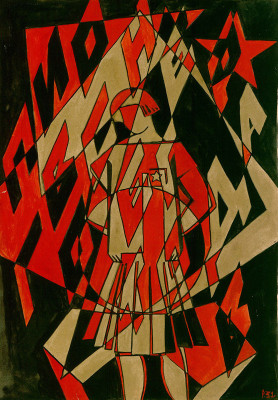Soviet Red Star
Rozalia Rabinovič (Kiev, 1985 – Moscow, 1988) is one of the most original and less known interpreters of the Soviet propaganda. After the first European appearance at the Biffi Gallery in Piacenza, a selection of about fifty drawings, realized between 1930 and 1938, is shown in Rome, under the flamboyant light of the Soviet Red Star, to tell about myths, symbols and protagonists of the Stalin era, in the passage from the most revolutionary avant-garde to the full development of the Soviet Realism. In the primary colours red and black, and in a sacred abundance of gold, Rozalia Rabinovič paints a world in construction and Stroim! (let’s build!) is the keyword that echoes between smokestacks, running trains, diggers, zeppelins, airplanes flying by the steeples of the Kremlin.
In the creative project of a world with a “bright future” everyone is involved: homeland fathers, young conscripts, and the heroes, from the workmen to kolkhoz women, from the aviators to the new soviet women. In a magnificent scenic design, in a heroic glorification of the geometry, the smokestacks rise in the sky, Lenin shows the way, the airplanes and the zeppelins fly all over Soviet Union, Stalin announces the quinquennial plans, the pioneers play the drums, the brave parachutists launch themselves, the tractors and the diggers conquer new lands, and the locomotives, symbol of the machinery culture, link Moscow to Leningrad in only seven hours.
These impressive deeds of muscles and gears are sung out by a delicate, shy woman, sister of Isaac Rabinovič, one of the most important set designer of the Bolshoi. Together they study in Kiev in the ateliers of Alexander Murashko and of Aleksandra Ekster (1882 – 1949). Together they arrive in Moscow on the wave of the Revolution. In Moscow Rosalia is a student of Robert Falk’s painting class in the prestigious VChUTEMAS school, a famous school of art of the 1920s, somewhat parallel to the German Bauhaus. Under her brother’s wing, who protects her but also hides her talent, Rosalia realizes a series of drawings for fabrics, propaganda panels, posters for the GUM stores, and furthermore sketches for the party diplomas and awards. In 1933 she is teaching in the “Central Art House for Children Education” and the drawings of her students are shown at Paris Expo in 1937 and at the World’s Fair of New York in 1939. After the War, in 1948, she participates to the construction of the Soviet Palace. Since 1950 she teaches in the painting atelier for children in the “Architecture House of Moscow”. After Stalin’s death, she works on more sentimental and intimate themes. The red colour disappears and a palette of faint and delicate colours arises.
At the end of the Stalin period, the propaganda drawings are kept hidden by the artist in her own house, in the Komunalka at n.17 Ulitsa Staraya, in Moscow, where Rosalia Rabinovič has been living since 1929 until the day of her passing, on february 4th 1988, being 92 years old. Only after her death, the drawings from the ‘30 came back to light fortuitously, from one of her nephew’s hands.

1931

1932
BBC
Popular Mechanics
Amica · Le nevi del tempo (PDF)
National Geographic · Tracce di un'utopia (PDF)
La Stampa · "Storie sovietiche" in mostra a Roma (PDF)
Corriere della Sera · Storie sovietiche. Pittura e fotografia di Rabinovic, Vasiliev e Tkachenko (PDF)
IO DONNA · Rozalija e il senso per l'arte della propaganda (PDF)
La Repubblica (ed. nazionale) · Obiettivo Russo: Scatti d'artista (PDF)
Marie Claire · Arte+Foto a Roma (PDF)
Touring · Storie Sovietiche (PDF)
L'Espresso · La mia Russia prigioniera (PDF)
L'espresso
National Geographic
Internazionale
La Repubblica
Touring Club
FP Magazine
Rolling Stone
Whatsart
IL POST

